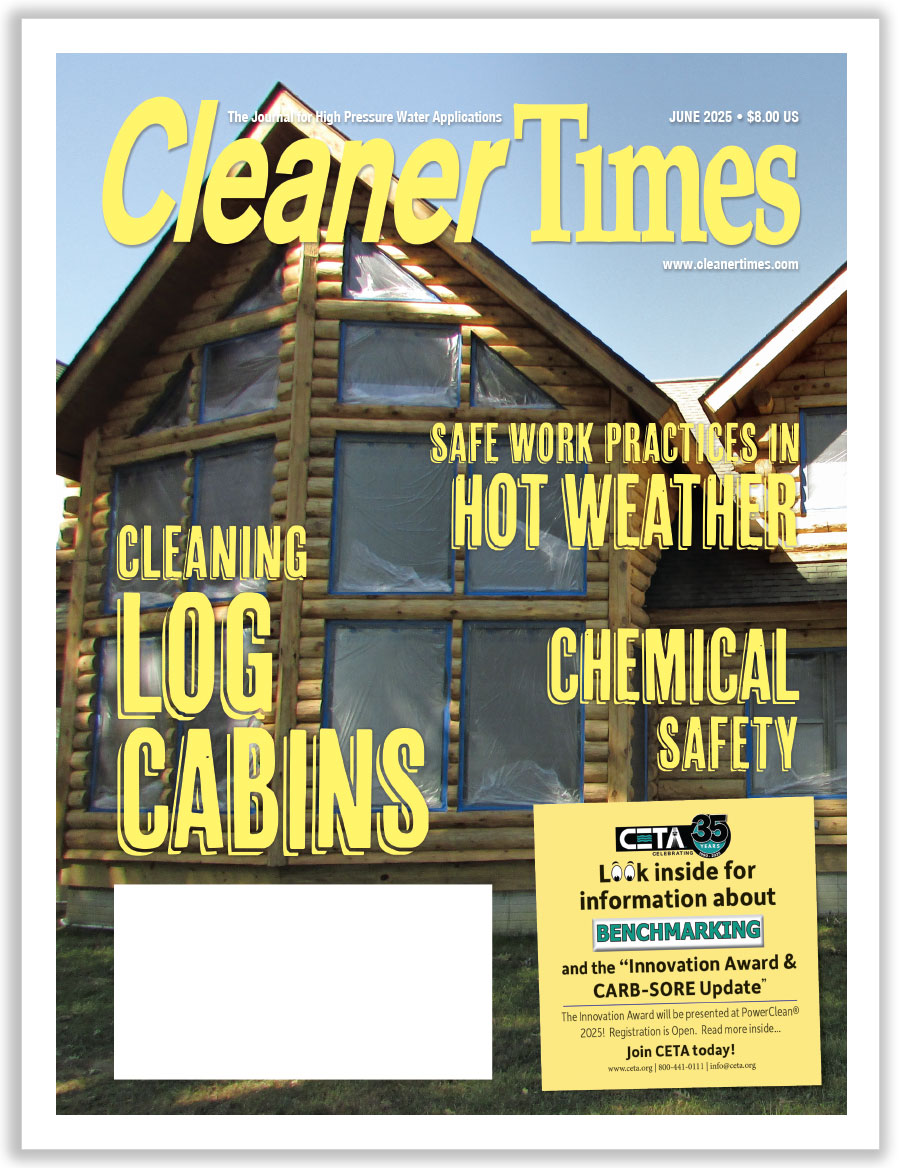
Using Steam in Restoration
By Diane M. Calabrese / Published June 2018

Do no harm. Restoration cleaning is about removing contaminants. It’s also about treating the substrate being cleaned and adjacent structures with TLC.
It takes a measured approach to strike a balance between gentle and effective. The U.S. General Services Administration (GSA), which has
responsibility for maintaining federal buildings, offers a short list of why “building fabric” of a historic structure requires attention.
Erosion and abrasion; chemical deterioration or corrosion; mold; bird, insect, and plant materials; and human behavior (as the GSA politely characterizes it) all prompt the need for care. (In some documents the GSA is forthright about the behavior category, listing graffiti and soiling caused by urine and blood.)
The GSA approach to restoration is prescriptive and detailed. For any contractor searching for a viable approach to handling a tough cleaning project, the recommendations provided by GSA (www.GSA.gov) make an excellent resource. In April, the GSA had 32 separate entries for how to remove stains from concrete. The stains ranged from asphalt and beverage to tobacco and wood.
Irrespective of substrate or contaminant, the GSA protocols start at the same place: testing. Although chemicals, pressure, hot water, and steam are not verboten, the advice is to “always start with the mildest method,” and that is water and soft brushes. If the GSA can be persuaded steam is the optimal approach, a contractor will be permitted to use it.
One of the most cited publications about using steam in restoration is a special technical bulletin (number 935, edited by James R. Clifton) from ATSM that derived from a 1983 symposium, Cleaning Stone and Masonry. An entry by Larry D. Jones titled “Selection of Most Appropriate Cleaning Method” addresses steam.
Jones wrote that steam was once popular because of availability, but that it was no longer in wide use in architectural cleaning. Risk to operator and slow speed are negatives he attached to steam, and he did not consider steam vapor to have the impact of liquid water.
In 2013, David Odgers wrote the entry “Steam Cleaning” for The Building Conservation Directory (www.buildingconservation.com/articles/steam-cleaning/steam-cleaning.htm). He sees a role for steam cleaning.
Odgers offers as clear a text as one can find on the benefits of steam and the precautions that must be taken when using steam in restoration. (The Building Conservation Directory is the finest single collection of articles on building restoration we have seen, at www.buildingconservation.com/articles/articles.htm#cleaning.)
Summarizing the merits of steam cleaning, Odgers points to its advantages in removing microbial growth and coatings with less water than hot water washers. The advent of machines that deliver steam and remove residue has eliminated a negative of steam cleaning, which was an obstructed view for the operator.
Readers are very familiar with the small industrial steam units that are sold to homeowners, who use them to clean stainless steel counters, floors, bathroom tiles, windows, and mirrors. Such units are also effective tools for cleaning carved detail on sculpture and monuments, according to Odgers, who writes that they are a match for marble, but not for alabaster (a variety of gypsum).
In March 1995, the U.S. Army Corps of Engineers (USACE) published Technical Report REMR-CS-46 titled “Repair and Maintenance of Masonry Structures: Case Histories” (authored by Edward F. O’Neil). The open-source document is a robust resource for any contractor involved in restoration cleaning or any manufacturer or distributor aiming to serve such a contractor. (See the full document via www.dtic.mil/dtic/tr/fulltext/u2/a294186.pdf.)
The case studies in the USACE document are instructive for contractors considering a bid on a restoration project. By consulting the case studies, a contractor can find a structure with similar construction and requirements for cleaning (as part of restoration), thereby having a good foundation for developing a plan for testing—always the first step.
Surface treatment, which may be part of cleaning, should not plug pores in stone and masonry carvings, for example. Low viscosity liquids with small molecular size allow for coating, but not plugging, of pores. As our readers know, the last thing a contractor wants to do is apply a coating that will seal the surface so moisture is trapped beneath the sealed surface. That entrapment is a sure way to exacerbate deterioration if freezing occurs and the force of frozen water (ice) acts on the structure.
Twenty-three years ago when the USACE report was written, repair and restoration were deemed more economical than razing a structure. Although that scenario is reversed today, the interest in restoring buildings has not abated.
Speed and cleaning as part of restoration stand opposed. Be prepared to commit time to the proposal, preparation, and process if your company is getting involved in steam cleaning (or any cleaning) as part of restoration.
A proposal to the GSA, for instance, must address safety precautions, historic building precautions, submittals, quality assurance, delivery (storage and handling), site conditions, sequencing and scheduling, and protection of the surrounding surface. The GSA—like other entities concerned with custodial care and restoration of historic buildings—remains open to any approach that accomplishes the goal with sensitivity to the structure and with all required environmental safeguards in place.
What We Talk About
When we talk about cleaning with steam, we may not always be talking about the same thing. Some would argue that cleaning with steam is a form of low-pressure washing with hot water. They make the assertion because steam is a mixture of water vapor and condensate, given that as soon as steam leaves a nozzle it begins to condense.
A distinction is typically made between dry steam and wet steam. Dry steam has a liquid component of zero. Or, in other words, there is no condensed moisture in the mix.
Wet steam is what most steam cleaning machines produce. It earns the moniker “wet” because water vapor and condensate are mixed.
Saturated steam occurs at the temperature and pressure at which both the liquid and vapor are in equilibrium. Water boils at 212º F, but it takes an extra input of energy to move it from its liquid phase to its gaseous (vapor) phase at the same temperature.
Moreover, although steam may be sanctioned on some restoration cleaning jobs, there may be restrictions on hot water used in conjunction with chemicals. Using water hotter than 160º F can cause discoloration or streaking on masonry and stone. And hot water is not a match when using acidic masonry cleaners. In its favor, however, is a combination of hot water and low pressure in removing grease, oil, and paint.
Manufacturers of steam cleaning machines offer end users choices in nozzles. Pressure can be minimized by choosing a nozzle with a wide angle that sprays in a fan pattern. Once an end user knows the goal, a manufacturer or distributor can assist with matching a nozzle. The shape of a nozzle changes the diffusion temperature of the spray as well as the pattern of the spray.
GSA and USACE are only two of the government entities with interest in best practices in restoration. The National Park Service (NPS) of the U.S. Department of the Interior is a third. In 2017, the department published its revised (by Anne E. Grimmer) edition of The Secretary of the Interior’s Standards for the Treatment of Historic Properties with Guidelines for Preserving, Rehabilitating, Restoring & Reconstructing Buildings. The open-source document (www.nps.gov/tps/standards/treatment-guidelines-2017.pdf) provides an introduction to construction materials found in historic structures and guidelines for maintenance.
The NPS document reflects a conservative perspective on how to maintain structures. It recommends cleaning masonry only when
necessary to halt deterioration or remove heavy soiling. If cleaning of masonry is done, it should be done by the gentlest method possible, such as with low-pressure water and detergent and natural bristle or other soft brushes.
Yes, the advice to be gentle appears again and again in recommendations for restoration cleaning. It’s correlated with the primary concern that no harm be done to historic structures.
The format of the NPS document—charts for materials that put “recommended” and “not recommended” side by side—makes it easy to use. Headers for recommendations include masonry (stone, brick, terra cotta, concrete, adobe, stucco and mortar), wood (clapboard, weatherboard, shingles, and other functional and decorative elements), and metals (wrought and cast iron, steel, pressed metal, tinplate, copper, aluminum, and zinc).
The NPS also offers an explanation of the prevailing concepts about how to treat historic structures. Preservation puts the focus on maintenance with the objective of retaining the form, as it has evolved.
Rehabilitation embraces the alterations necessary to meet use requirements while simultaneously trying to retain the historic character. Restoration aims to keep a structure in the state it was in during the period in which it was erected; it involves removing evidence of other periods, in the words of NPS. Reconstruction is the process of building historically accurate replacement parts for a structure.
Mechanical, chemical, water, steam, and (a recent addition) laser methods are all viable contributors to restoration. A full understanding of the construction and condition of a structure is the place to begin when testing and then proposing a method for cleaning.





